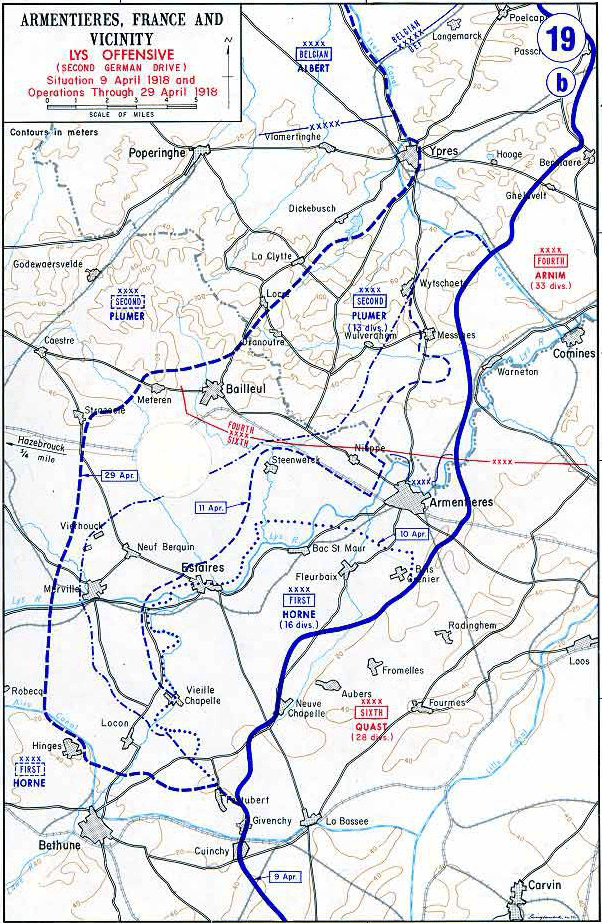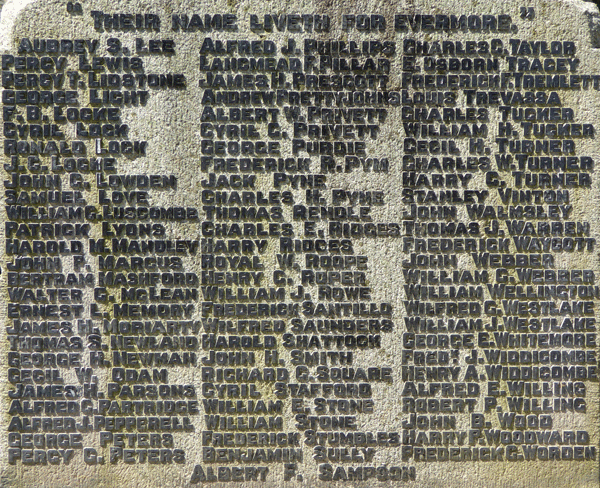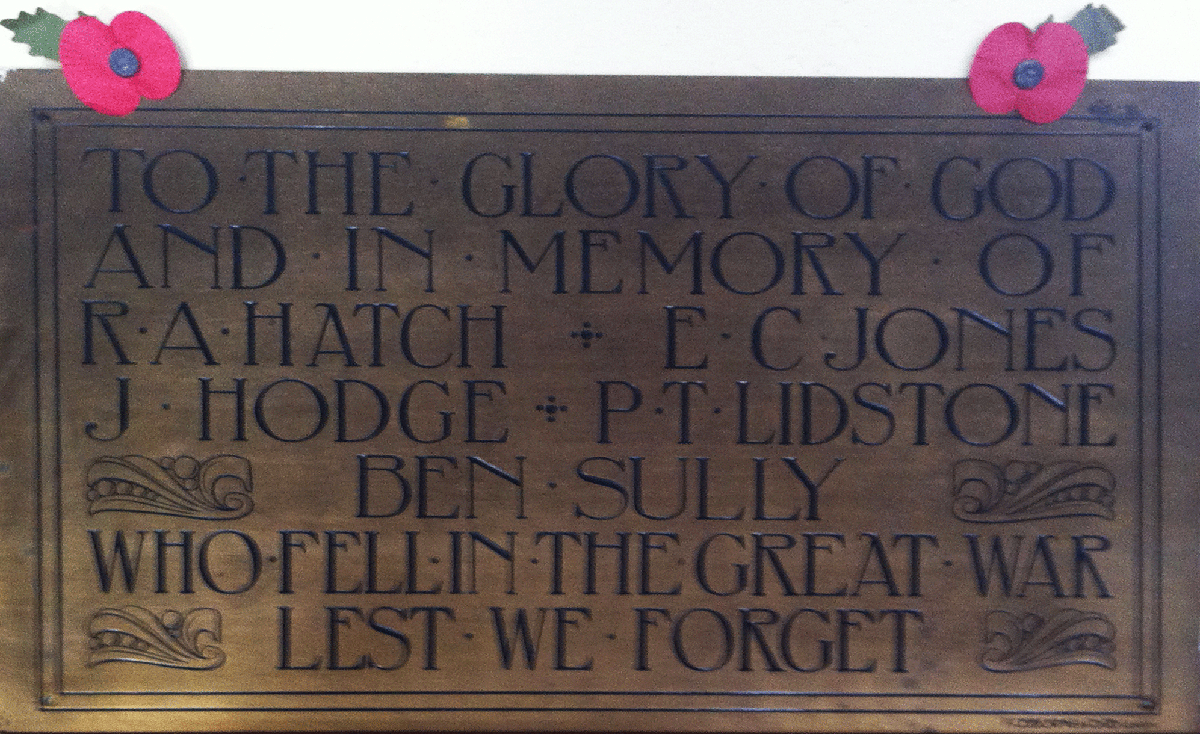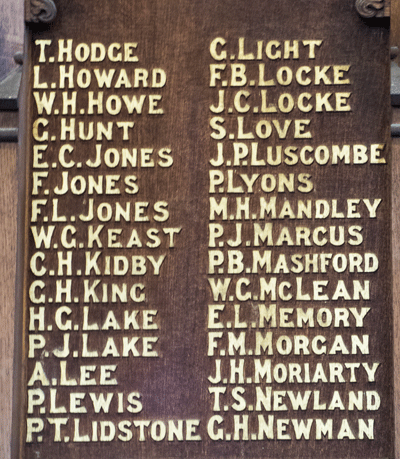Percy Trobridge Lidstone
Family
Percy Trobridge Lidstone was born in 1898 in Dartmouth. He was the eldest son of Thomas Lidstone and his wife, Beatrice Mary Chadder.
Thomas came originally from Plymouth, but by 1891 his family had moved to Torquay, where his father Philip worked for the Great Western Railway as a Porter. Thomas followed him into the same line of work, joining the GWR in February 1892 at Torquay as a "Lad Porter", a few months short of his sixteenth birthday, earning 9s per week. He moved to Marsh Mills station, near Plymouth, in January 1895, and then for a few months to Starcross, before joining the staff of Kingswear station in March 1896. GWR records show that by then he was earning 18s per week.
It was presumably after Thomas moved to Kingswear station that he met Beatrice Mary Chadder. She was the daughter of John Chadder and his wife Leah, who had moved to Dartmouth from Stokenham. John was a Stoker at the Gasworks in Dartmouth.
Thomas and Beatrice married early in 1898 and Percy was born towards the end of the same year; a sister, Rita Leah, was born in 1900. By the time of the 1901 Census the family lived in Browns Hill. Thomas was still working as a porter at Kingswear Station.
Thomas and Beatrice's third child, Thomas Gerald, was born in 1904. The census of 1911 recorded the family living at 1 St Petrox Cottages, Lake Street. All three children were at school. Thomas still worked at Kingswear Station, but shortly after the census was taken, in May 1911, he was moved to Moretonhampstead, with a reduction in his weekly wage, due to "general inattention to duties". He remained at Moretonhampstead for two years until February 1913, when he was moved to the role of "Goods Checker", at South Molton. Here his employment record shows that, on 30th March 1914, he "caused slight damage to three horse boxes during shunting operations at South Molton".
It is not clear if the rest of the family moved away from Dartmouth as a result of Thomas' change of job on the railway system. Another daughter, Marjorie Edna, was born in 1914, but sadly Thomas died in 1916 aged only 39. This is likely to have been only a few months before Percy joined up.
Service
Percy's service records have not survived so his service must be pieced together from a range of sources. The Medal Roll of the Hampshire Regiment, in which he was serving when he died, shows that he had served only in the 2nd Battalion; his service number was 42345. Surviving records of men with numbers close to Percy's suggest that he was probably called up in early 1917, which would have been soon after he had turned eighteen.
In 1916 compulsory military service was introduced; the second Military Service Act of May 1916 made liable for military service all men aged 18-40 inclusive, single and married, although no-one would be sent abroad until he had reached the age of 19. The arrangements for training were re-organised in September 1916 when the Training Reserve was set up. Infantry regiments no longer recruited locally; reserve units which had the function of training recruits for their regiments became Training Reserve Battalions. Other men posted to the Hampshire Regiment with numbers close to Percy's were sent to 94th Training Reserve Battalion at Chiseldon, Wiltshire; it seems likely that this was also his destination. If so, he will have arrived there at about the same time as William Waldo Summers Elliott, who also served in the Hampshire Regiment.
Following a further reorganisation of Army Training in 1917, the 94th TR Battalion was redesignated a "Graduated Battalion", for soldiers aged between 18 years 5 months and nineteen years. As the name implies, soldiers were posted to "Graduated" Battalions having received their initial training with a "Young Soldiers" Battalion, for specialist training until they were old enough to be drafted. The 94th TR Battalion was redesignated at about the same time as Percy reached this stage in his training, so he may well, like others of his age, have remained with the same training Battalion throughout.
Percy will have turned nineteen towards the end of 1917 so would have been expected to be posted for service abroad at that time; others with a service number close to his were sent to France in early December 1917, joining the 2nd Battalion during December and January. The War Diary of the 2nd Battalion Hampshire Regiment shows several small drafts joining in December 1917, two fairly large drafts of 58 and 60 men joining on 2nd and 9th January 1918, and several other small drafts thereafter, totalling 189 reinforcements.
The 2nd Hampshires, part of 88th Brigade in 29th Division, were out of the line during this period, billeted at Acquin in France. On 18th January their rest and training period came to an end and they were sent forward into the Passchendaele sector, going into the front line on 26th January for four days. Most of February and the first few days of March were spent behind the line in training, until they went back into the front line immediately north of Passchendaele on 7th March.
On 10th March 1917, the Battalion's War diary reported: "Nothing unusual". One man was wounded. The following day, they came under attack, which they repelled.
About 5.55am the enemy opened an intense barrage immediately in front of our posts … the enemy were observed to be forming up in No Mans Land. At 6.05am the SOS Signal was sent up … in less than two minutes the Artillery replied to our SOS and the enemy appeared to suffer heavy casualties. At 6.20am the enemy's barrage lifted to our support line and the enemy moved forward to the attack … [and] advanced in groups. At one point the enemy approached within bombing range but were ejected by bombing … [they] went back to their trenches and in doing so suffered still more by having to pass through our Artillery barrage. When the Artillery fire had died down the enemy began to collect casualties under the Red Cross Flag … No damage was done to our trenches and the enemy were conspicuously quiet the remainder of the day and night …
The situation remained fairly quiet the next day. On 13th March, however, a pillbox near Battalion HQ was hit by a gas shell. A wounded sentry crawled into the HQ dug-out:
…. taking with him some of the liquid gas on his clothes. The passage outside was also sprayed with the liquid … By 6pm the whole of Battalion HQ had been removed to the dressing station suffering from poison gas: the CO, Adjutant, Intelligence Officer, Medical Officer, Signalling Officer, the Regimental Sergeant Major, Signalling Sergt, Orderly Room Cpl, all the runners, signallers, officers' servants and medical aid staff …
The following day, which was quiet, the Battalion was relieved; and by March 17th, were billeted in the town of Poperinghe. The war diary observes, probably with a considerable degree of understatement: "The change was very pleasant and the men welcomed the cafes, estaminets and cinemas".
The rest lasted four days. As the German Spring Offensive began on the Somme, on 21st March 1918, the Corps Commander, Lt Gen Sir Aylmer Hunter-Weston, KCB, DSO, inspected the 88th Brigade's billets, paying particular attention to the Field Kitchens "of which he showed an intimate knowledge".
On 22nd March 1918, the Battalion went back into the line. They observed much movement in the enemy lines. On 25th March, they were hit not by bombs or shells but by German propaganda:
A German plan dropped papers [the] "Gazette des Ardennes" on our lines by means of small inflated balloons … In the evening the enemy sent us the latest battle news by visual from his balloon. News was to the effect that he claimed 80,000 prisoners and 200 guns.
They left the line on 26th March, suffering eleven men wounded from shellfire and machine gun fire while negotiating the duckboard tracks.
As they were cleaning up in camp after the line the next day, the arrival of various officers who had been withdrawn from courses owing to the "affair on the Somme", gave some clue that the claims were not just empty boasting. On 28th March 1918, the War Diary noted that the Germans had advanced to Bienvillers, where the Battalion had been billeted in October 1917, and had also recaptured the ground up to the old battle line of 1916. Nonetheless they remained where they were at Hasler Camp, reporting on 31st March that "News from the South is good and the enemy has been arrested … Things are generally quiet in this sector".
During March they had sustained, amongst the men:
- six killed
- 75 wounded and 14 died of wounds
- 78 sick to hospital
They had received another 108 reinforcements and their overall strength was at this point 35 officers and 927 other ranks. More reinforcements arrived on 1st April.
On 2nd April 1918 they went back into the line in the Passchendaele sector for four days, which were fairly quiet. The possibility of an attack around Ypres was strong, and much work had to be carried out to strengthen the line as far as possible in the time available. The War Diary observed as they came out: "… Men very tired as they have worked very hard during the tour to improve the defences of the salient and have had little rest". Back at Hasler Camp they rested and cleaned up; the next couple of days were spent in working parties doing much the same thing as they had done while holding the line.

Battle of the Lys
At this point the call finally came; 88th Brigade were rushed south to a point between Bailleul and Hazebrouck where "the enemy was reported to be advancing". They arrived on 10th April as the German assault on Hazebrouck was developing:
By the evening the line of the Bailleul-Armentieres road had been established but touch with Nieppe could not be obtained and the situation near Armentieres was obscure."
At 8am on 11th March, "X" Company was holding the outpost line from Steenwerck station (a little to the north of the town) to a small village called Trois Arbres (now the location of a CWGC Cemetery), with the other three companies in rear. The line ran parallel and to the south of the Bailleul-Armentieres road (now the D933). "W" Company was ordered to advance through "X" Company towards Steenwerck, but patrols found the enemy "in force" and the order was eventually countermanded. During the afternoon and evening they held their position though subjected to heavy fire.
As the Official History points out, the position of the 34th Division, to which the 88th Brigade was now attached was "dangerous in itself, but would be left isolated if on either side of it the divisions against which the main enemy attack had so far been directed, should be driven back". The retirement began at 7.30pm, with the 88th Brigade covering the forward troops. The rearguard, including 2nd Hampshires, remained in position until 1am on 12th March. By dawn they had taken a line from Steenwerck station on the right to the village of Seule on the left, with their left flank on the Bailleul-Armentieres road. The position is more or less in the centre of the map shown above.
Attached temporarily to the Hampshires were other units thrown into the battle - 100 men and two officers of the 20th Middlesex were in Battalion Reserve "employed in local counter-attacks"; 497th Field Company Royal Engineers, whose CO had been badly wounded by machine gun fire while leading a counter-attack; and 1st Bn East Lancashire Regiment had also been attached to the Hampshires for a short time.
During 13th April the 34th Division was subjected to general attack. According to the Official History:
… the pressure of at least four enemy divisions on five weak brigades was proving too heavy and the resulting casualties too severe to justify a further stand. As a collapse on the left would endanger the long front facing south on either side of Bailleul, the 34th Division … sanctioned the withdrawal …
As the 2nd Hampshires War Diary observed: "the position held by the 88th Bde was … becoming very precarious". They withdrew at 10pm. By dawn on 14th April the Battalion was "dug in, in a new position two miles north-east of Bailleul":
[the enemy] attempted to advance in small groups towards the foot of our position which was one of extraordinary strength. To reach us the enemy had to cross a marsh in full view for 1000 yards; at the same time little movement on our part was possible and our positions were fire marks for artillery, a fact which the enemy fully appreciated …
The front around Bailleul was attacked all day by the Germans, but without success. Although brigades and formations had become highly intermingled, the front held. The sector including the 2nd Hampshires was relieved by two brigades of the 59th Division overnight. They had been held back in a defensive position in the second line and so, as the Hampshires War Diary records, did not come up until 3.40am, quite close to dawn. The Hampshires thus had "barely crossed the ridge before visibility got good". By 7am they reached Croix de Poperinghe, where they were able to get a wash, a meal and a certain amount of rest, until they were once more thrown into the battle later that day.
Death
The German advance was far from over in this sector - Bailleul fell on 15th April - but Percy's war had come to an end. Despite the difficult situation, the 2nd Battalion was evidently able to keep daily records of casualties, including numbers of those sick as well as those killed, wounded and missing, and these were duly transferred in due course into the War Diary. All the available records are clear that Percy was killed in action on 14th April, and the War Diary records for that day six other ranks killed, nine wounded, and three sent to hospital (one officer was also wounded).
News reached Dartmouth quite rapidly. On 3rd May 1918, the Dartmouth Chronicle reported that "Pte Percy T Lidstone, 2nd Bn Hants Regt, of Newport Street Dartmouth was killed in action on April 14th". The news was reported at the same time as the death of Frank Hodge who had been killed five days earlier.
An announcement was placed by his mother in the newspaper the following week:
Deaths
Lidstone - Killed in Action in France April 14th, Pte Percy T Lidstone, 2nd Bn Hants Regiment, eldest dearly loved son of the late T Lidstone and Mrs Lidstone, of Newport Street, Dartmouth, aged 19 years.
Percy's name appeared in official casualty lists published in newspapers in early June (for example, in the Western Times on 6th June 1918).
Commemoration
The area where Percy was killed was very soon overrun as the German attack continued. Evidently his body was never found or never identified. Percy is commemorated on the Ploegsteert Memorial, which records the names of more than 11000 men who died in this sector during the Great War, and, as it says on the memorial: "to whom the fortune of war denied the known and honoured burial given to their comrades in death".



In Dartmouth, Percy is commemorated on the Town War Memorial, the St Saviours Memorial Board, and a memorial in the Flavel Church.
Note: Percy's second name is spelt variously in different records as "Troubridge", "Trowbridge" or "Trobridge". The last appears to be the way the family spelt the name so we have followed this.

Sources
The War Diary of 2nd Battalion Hampshire Regiment March 1916 - February 1919 is available from the National Archives, fee payable for download, reference WO 95/2308/3
History of the Great War, Military Operations, France and Belgium, 1918, Volume 2, March-April: Continuation of the German Offensive, by Brig-Gen Sir James E Edmonds, pub Macmillan, London, 1937
Information Held on Database
| Surname: | Lidstone |
| Forenames: | Percy Trobridge |
| Rank: | Private |
| Service Number: | 42345 |
| Military Unit: | 2nd Bn Hampshire Regiment |
| Date of Death: | 14 Apr 1918 |
| Age at Death: | 19 |
| Cause of Death: | Killled in action |
| Action Resulting in Death: | Battle of the Lys |
| Place of Death: | Near Bailleul, Nord, France |
| Place of Burial: | Ploegsteert Memorial, Belgium |
| Born or Lived in Dartmouth? | Yes |
| On Dartmouth War Memorial? | Yes |
| On St Saviour's Memorials? | Yes |
| On St Petrox Memorials? | No |
| On Flavel Church Memorials? | Yes |
| In Longcross Cemetery? | No |
| In St Clement's Churchyard? | No |
| On a Private Memorial? | No |
| On Another Memorial? | No |















